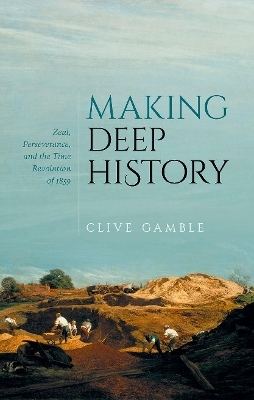
Making Deep History
Oxford University Press (Verlag)
978-0-19-887069-2 (ISBN)
One afternoon in late April 1859 two geologically minded businessmen, John Evans and Joseph Prestwich, found and photographed the proof for great human antiquity. Their evidence -- small, hand-held stone tools found in the gravel quarries of the Somme among the bones of ancient animals -- shattered the timescale of Genesis and kicked open the door for a time revolution in human history.
In the space of a calendar year, and at a furious pace, the relationship between humans and time was forever changed. This interpretation of deep human history was shaped by the optimistic decade of the 1850s, the Victorian Heyday in the age of equipoise. Proving great human antiquity depended on matching the principles of geology with the personal values of scientific zeal and perseverance; qualities which time-revolutionaries such as Evans and Prestwich had in abundance. Their revolution was driven by a small group of weekend scientists rather than some great purpose, and it proved effective because of its bonds of friendship stiffened by scientific curiosity and business acumen.
Clive Gamble explores the personalities of these time revolutionaries and their scientific co-collaborators and adjudicators -- Darwin, Falconer, Lyell, Huxley, and the French antiquary Boucher de Perthes -- as well as their sisters, wives, and nieces Grace McCall, Civil Prestwich, and Fanny Evans. As with all scientific discoveries getting there was often circuitous and messy; the revolutionaries changed their minds and disagreed with those who should have been allies. Gamble's chronological narrative reveals each step from discovery to presentation, reception, consolidation, and widespread acceptance, and considers the impact of their work on the scientific advances of the next 160 years and on our fascination with the shaping power of time.
Clive Gamble is an archaeologist and Emeritus Professor at the University of Southampton. He is currently a member of its Centre for the Archaeology of Human Origins that he founded in 2001. His recent participation in the British Academy's Centenary Project brought together archaeologists and psychologists to research when hominin brains became human minds. The results are published in Thinking Big: How the Evolution of Social Life Shaped the Human Mind (2014, with John Gowlett and Robin Dunbar). He is a Fellow of the British Academy, the Society of Antiquaries of London, and the Royal Anthropological Institute. He is President of the Prehistoric Society and from 2010-2018 was a Trustee of the British Museum.
1: The Time r=Revolutionaries of 1859
2: Discovery: The Day April 27th 1859
3: Presenting the Evidence: The Month, May to June 1859
4: Reception: The Year 1859-1860
5: Consolidation: The Decade Begins 1860-1863
6: Acceptance: The Decade Closes 1864-1872
7: A Legacy of Zeal and Perseverance
8: Afterword: The Stone That Shattered the Barrier of Time
| Erscheinungsdatum | 17.02.2021 |
|---|---|
| Zusatzinfo | 52 |
| Verlagsort | Oxford |
| Sprache | englisch |
| Maße | 145 x 221 mm |
| Gewicht | 568 g |
| Themenwelt | Geisteswissenschaften ► Archäologie |
| Geschichte ► Allgemeine Geschichte ► Vor- und Frühgeschichte | |
| Sozialwissenschaften | |
| ISBN-10 | 0-19-887069-8 / 0198870698 |
| ISBN-13 | 978-0-19-887069-2 / 9780198870692 |
| Zustand | Neuware |
| Informationen gemäß Produktsicherheitsverordnung (GPSR) | |
| Haben Sie eine Frage zum Produkt? |
aus dem Bereich


